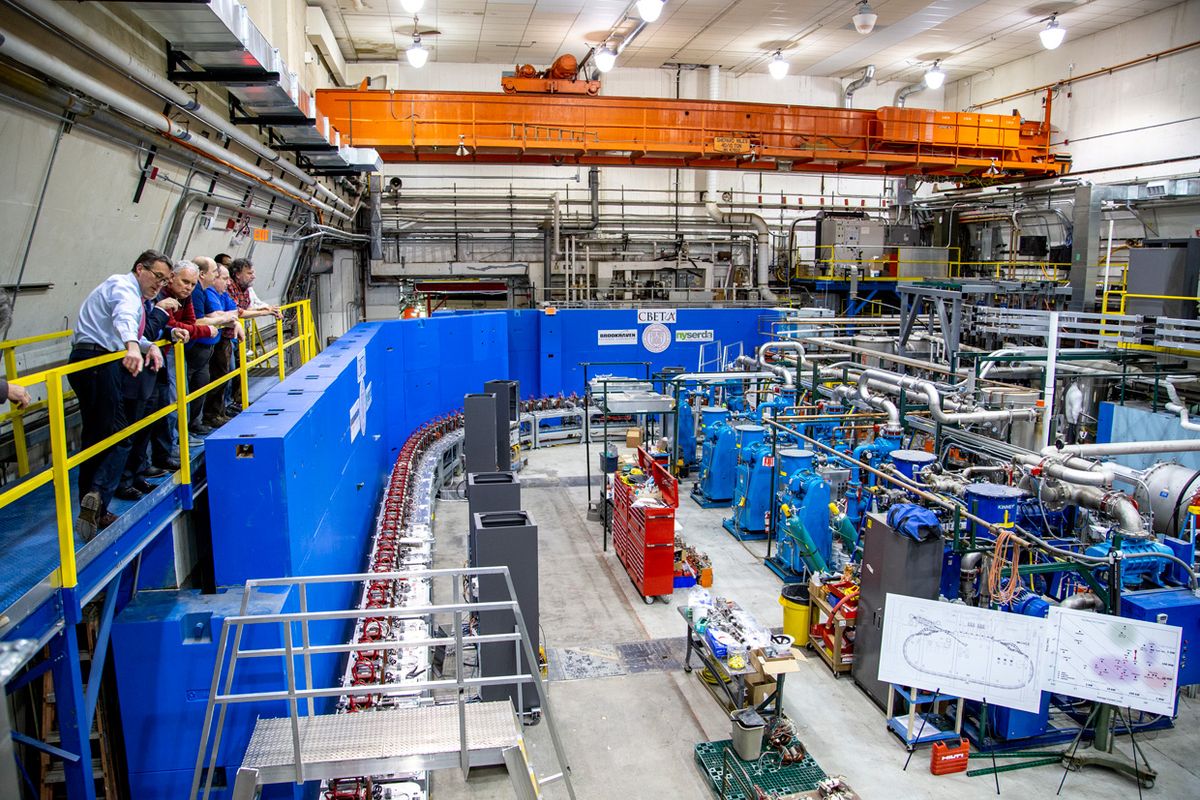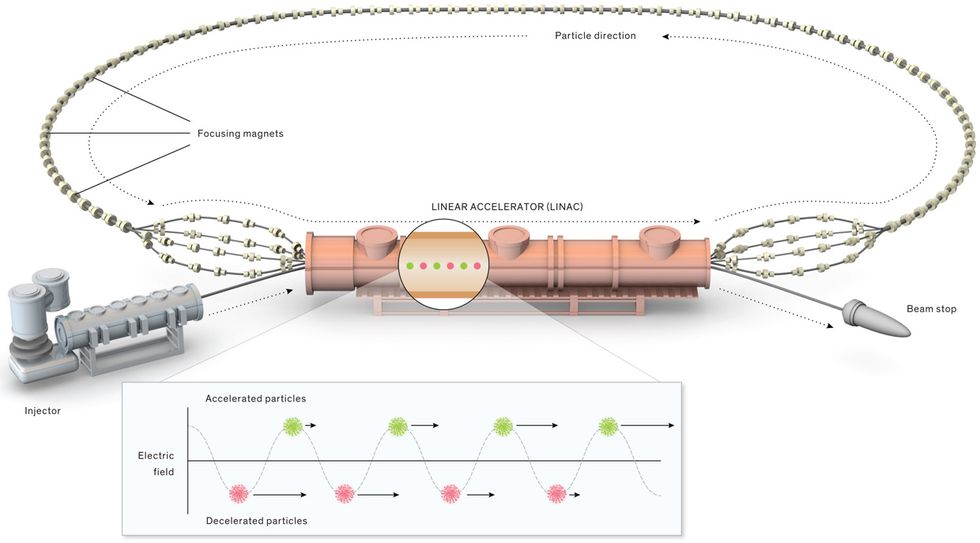Accelerator physicists from Cornell University and Brookhaven National Laboratory have facilitated an unprecedented energy handoff between electrons.
As particle colliders have gotten bigger and more expensive to build and operate, physicists have begun to look for nontraditional ways to accelerate particles. One potential solution is to use energy recovery linear accelerators, or ERLs. These new particle accelerators transfer energy from decelerating electrons to give fresh particles a boost—similar to the way speed skaters transfer energy by physically pushing their teammates forward to begin each new leg of a relay.
CBETA (short for Cornell-BNL ERL Test Accelerator) is a proof-of-concept experiment for such next-generation accelerating technology. Last December, researchers managed to achieve what's called eight-pass energy recovery for CBETA, a benchmark that shows the technology's potential for future colliders.
Conventional particle accelerators fall into one of two main classes: linear accelerators or storage rings. Linear accelerators, also known as linacs, are hollow metal chambers filled with strong electric fields. These fields flip on and off, and with the right timing, charged particles inside the chambers can be propelled forward or backward. The resulting particle beam is dense but has relatively few particles.
Storage rings circulate particles millions of times by bending their paths with magnets. Particles can be continually injected into a storage ring, which creates a beam with more particles. But the beam has lower density, becoming diluted as the particles circulate.
Georg Hoffstaetter, a physics professor at Cornell who leads CBETA, says ERLs combine the strengths of both. “We have two traditional accelerator technologies: linacs, which can provide low current but very dense beams, and rings, which can provide high current but less dense beams," he says. “An ERL merges these two technologies to get both advantages—to get high currents for very dense beams."
Trying to make two beams of particles collide results mostly in misses because the particles are incredibly small. Physicists love dense beams and high currents because both qualities provide more collisions and therefore more data.
The concept of an ERL has been around since 1965, when Cornell physicist Maury Tigner proposed it, but the technology has become attractive only in recent years, in part because of how complex the energy handoff is to execute.
In ERLs, particles are initially accelerated by a linear accelerator. Magnets then “loop" the particles back to the beginning so that they pass through the linear accelerator again. In CBETA, electrons make eight full passes. On the first four, the electrons gain energy. But after the fourth pass, they arrive out of sync, and the electric field, instead of pushing them forward, slows them down.
As with speed skaters, when these electrons slow down they lose their kinetic energy. But energy is conserved—it has to go somewhere. For skaters, the energy moves through a push to the next skater; for electrons, the energy moves through the electric field to the next accelerating electron. After an electron finishes its fourth deceleration, it's discarded.
Because they combine the advantages of both linacs and storage rings, ERLs present a tempting alternative to current collider tech. Besides CBETA, a few other ERLs have achieved full energy recovery, but not for eight passes. More passes give the electrons higher energy, but this also makes the particles more difficult to control.
“ERLs are notoriously hard to commission, and the fact that they've managed eight-pass recovery using permanent magnets is quite a feat," says Ryan Bodenstein, an accelerator physicist at the Belgian Nuclear Research Centre. “I'm really quite excited about this breakthrough."
The European, Japanese, and American particle-physics communities are deliberating what future accelerators to fund. CBETA's success may cause them to take another look at ERLs—which, thanks to their smaller size and power savings, reduce costs. Some future experiments, such as an electron-ion collider to be built at Brookhaven, will use ERLs.
ERLs still face challenges, though. There are questions about whether the handoff would go as smoothly in a real collider: Smashing beams of electrons with ions or other particles could throw off the timing of the sensitive energy handoff. Design complications could take years to smooth out.
“I think the ideas should be pursued and investigated further," says Bodenstein. “And even if it doesn't really work out in this case, I think it will provide some great insights."
This article appears in the March 2020 print issue as “New Particle-Accelerating Tech Passes Test."
Dan Garisto is a freelance science journalist who covers physics and other physical sciences. His work has appeared in Scientific American, Physics, Symmetry, Undark, and other outlets.




